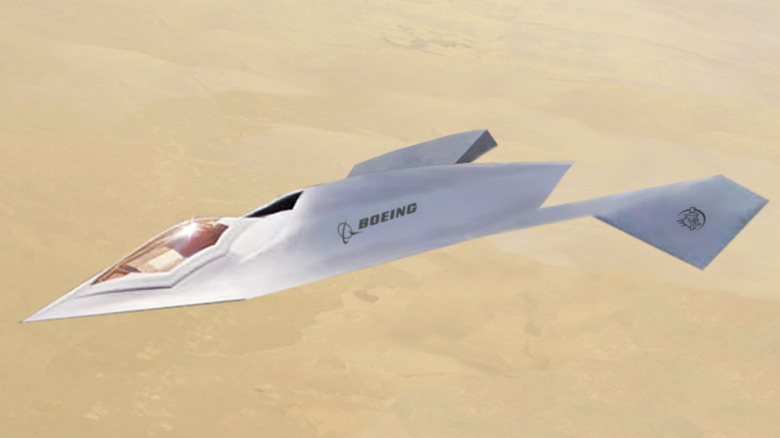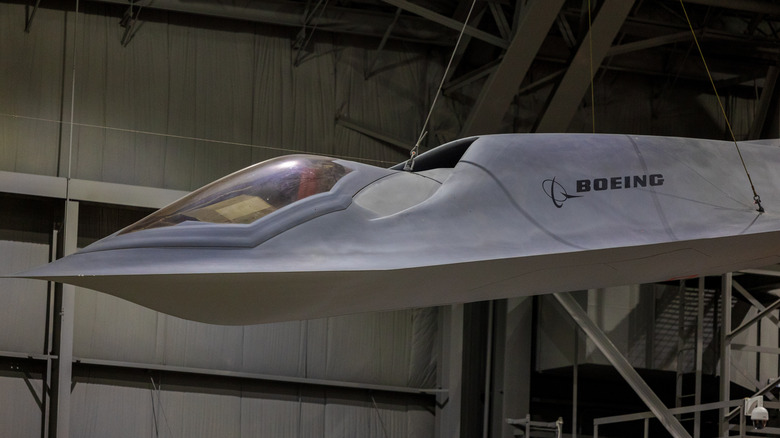This Futuristic Stealth Aircraft Got Its Name Straight From Star Trek
The iconic sci-fi franchise "Star Trek" has an interesting relationship with the U.S. military, especially when it comes to the names of ships and aircraft. This isn't a coincidence, since Gene Roddenberry, the writer and producer who created "Star Trek" in 1964, was a commissioned officer in the Army Air Corps. Drawing from that experience, he envisioned Starfleet — the fictional armada of spacefaring vessels that "Star Trek" revolves around — and based many of its characteristics on it. The flagship of the original "Star Trek" series was the U.S.S. Enterprise, which shared its name with a ship from the U.S. Navy as well as the world's first nuclear-powered aircraft carrier. NASA then named a space shuttle after the fictional Enterprise, creating a cyclical loop of vessel names.
"Star Trek" is still going strong nearly 60 years since its premiere, with new episodes from multiple series airing to this day, as well as continuing in video games, feature films, books, comics, conventions, and more. Over the years, other fictional ships from the franchise have taken their names from real-life Navy and NASA vessels, including the Yorktown, Discovery, and Intrepid. One aircraft developed by McDonnell-Douglas in the 1990s even shares its name with an iconic "Star Trek" ship that wasn't part of Starfleet, but rather one used by its interstellar enemies. Considering this jet prototype employed futuristic stealth technology, even casual Trekkies shouldn't be surprised which fictional spaceship it borrowed its name from.
[Featured image by FOX 52 via Wikimedia Commons | Cropped and scaled | CC BY-SA 4.0]
An iconic 'Star Trek' name
After failing for several years to secure contracts from the U.S. Air Force to develop and build new fighter jets, aerospace contractor McDonnell-Douglas decided to think outside the box. This resulted in the YF-118G, a plane intended to be cheap to build by incorporating pre-existing parts like its engine and landing gear. McDonnell-Douglas also used computer models and 3D rendering during development to lower production costs. The main draw of the YF-118G that set it apart, however, was its focus on stealth.
The YF-118G's design helped reduce its size and look significantly on radar. Supposedly, the radar cross section of the YF-118G was tiny as a bug. The YF-118G was also able to hide from infrared thanks to the placement of its engine deep in the fuselage. It was also painted to make it harder to identify even in broad daylight.
All of these advanced techniques to make the YF-118G nearly invisible, earning it an appropriate name from "Star Trek": the Bird of Prey. In the sci-fi franchise, Birds-of-Prey were antagonistic warships used by both the Romulan and Klingon Empires that employed futuristic cloaking technology. (The Romulan Bird-of-Prey first appeared in "The Original Series" in 1966 and the Klingon Bird-of-Prey debuted in 1984's "Star Trek III: The Search for Spock.") The Birds-of-Prey, many of which had actual feather designs painted on their underbellies, would shimmer and literally vanish by engaging their cloaking device. While the YF-118G couldn't quite achieve the same, its stealth design was certainly worthy of the Bird of Prey name.
A short future
Unfortunately for McDonnell-Douglas, the YF-118G did not survive into the 23rd century and beyond like its fictional "Star Trek" namesake. Boeing acquired McDonnell-Douglas in 1998 and unveiled the details of the Bird of Prey program in 2002. The aircraft had its first test flight in 1996 and another 37 over the next three years, but was never adopted by the United States Air Force. Despite minimizing its radar signature and observability, the aircraft suffered from inadequate aerodynamic performance. Its unique 23-foot wingspan (which did not have alien feathers painted on its underside) and eccentric stealth-focused shape hindered its handling, speed, and max altitude. It topped out at 260 knots and a maximum operating altitude of 20,000 feet, so the Air Force ultimately decided to employ other aircraft with more impressive specs.
The YF-118G Bird of Prey is spending its retirement in the National Museum of the United States Air Force in Dayton, Ohio, along with other aircraft prototypes like the Tacit Blue. It's suspended above ground, where visitors can admire its sci-fi looking design. If you want to see a Bird of Prey in action and using its futuristic stealth technology, however, you'll have to settle for watching the fictional ones seen in "Star Trek."
[Image by loganrickert via Wikimedia Commons | Cropped and scaled | CC BY-SA 2.0]

